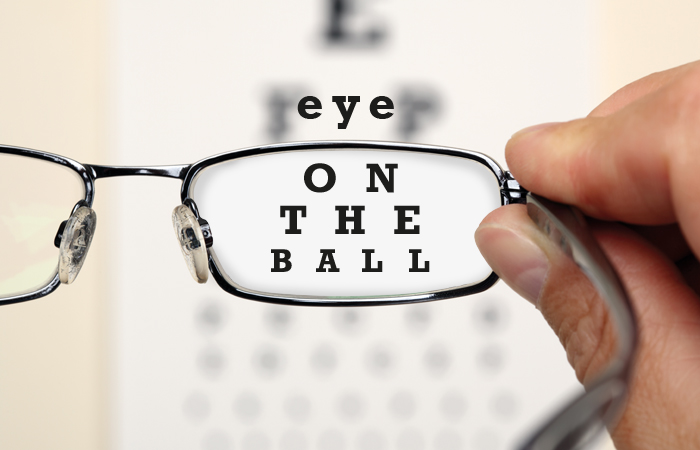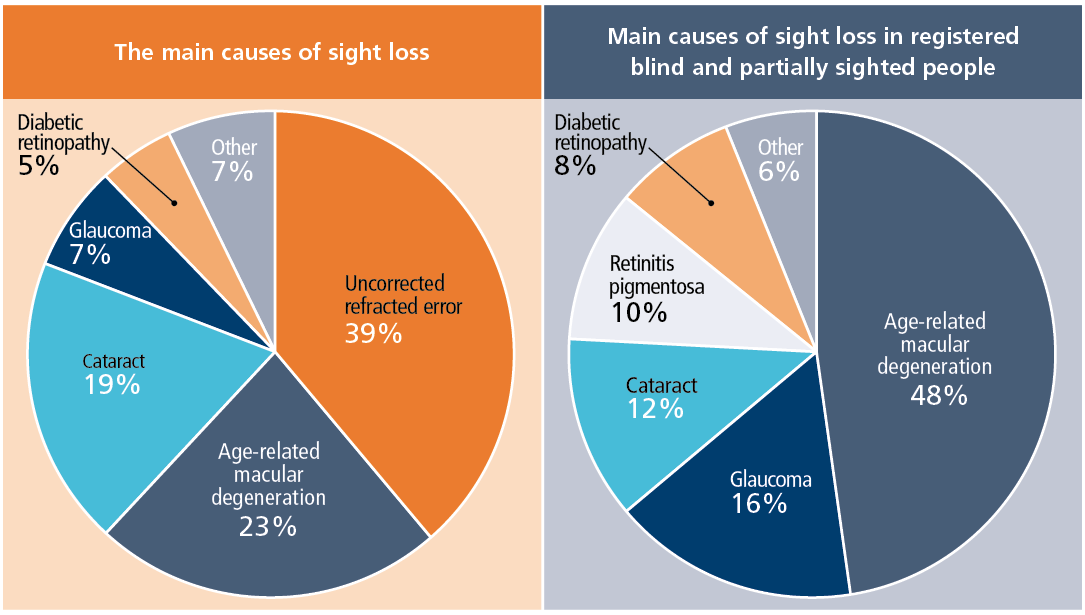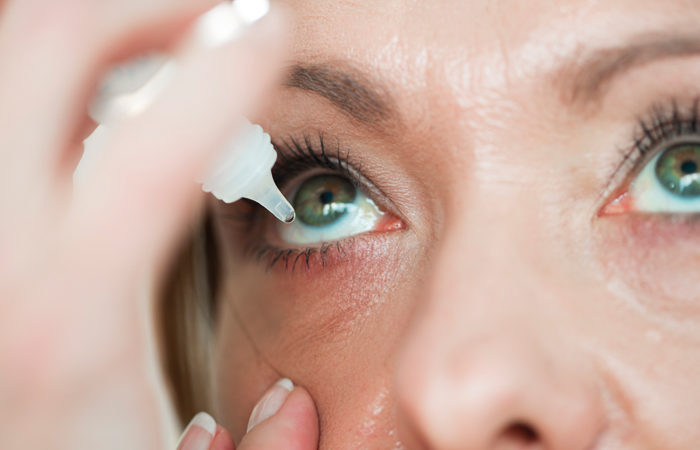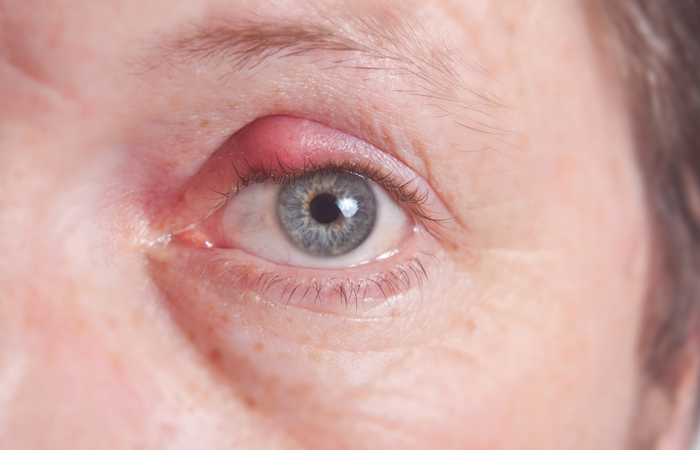Eye on the ball
In OTC
Follow this topic
Bookmark
Record learning outcomes
Over one in 30 people are estimated to live with significant sight loss. With this number set to double by 2050, it's important to understand the leading causes of sight loss and how pharmacy teams can help customers protect their eyes from damage.
Every day in Britain 250 people start to lose their sight, according to the Royal National Institute of Blind People (RNIB). Some two million people in the UK are currently affected by sight loss severe enough to have a significant impact on their daily lives. This is forecast to double to four million by 2050, says the RNIB, unless people take steps to better protect their eyes.

Some people are at higher risk of sight loss, with an estimated six million in the UK living with sight-threatening conditions such as diabetic retinopathy, glaucoma, cataract, age-related macular degeneration (AMD) and ocular hypertension.
“Eye conditions become more prevalent with age so with an ageing population the number of people diagnosed with these will naturally increase,” says Roshni Kanabar, optometrist and clinical and regulatory advisor at the Association of Optometrists.

Test effective
Everyone should have their eyes tested every two years, even if they don’t notice a change in vision, but 14 million people in the UK have not had one in the last two years, according to the RNIB’s latest State of the Nation: Eye Health report.
A health initiative by Vision Express offering free sight tests from its roving Vision Van found that 86 per cent of participants were overdue an eye test, 84 per cent had an outdated prescription and 20 per cent had never had an eye test. “The main reason for not having a sight test, given by 40 per cent of respondents, was that they did not notice any problems and therefore did not feel the need for a test,” says Roshni.
Louise Gow, specialist lead for eye health at the RNIB, says: “Our research suggests Britons check their teeth more often than their eyes. Some 42 per cent of UK adults visit their dentist every six months, while 25 per cent haven’t had an eye test in the past two years.”
A sight test is the most important way to protect vision by picking up problems early and enabling effective treatment to help prevent sight loss. Customers should be encouraged to have regular sight tests – at least every two years – and more often if their optician recommends it.
“Staff can help by asking when someone requests over-the-counter eye drops whether they have had a routine eye examination if their symptoms are non-acute, such as dry eye or allergies. When selling reading glasses, always ask whether the person has had a routine eye examination and explain it’s not just about selling spectacles, it is the way of checking eye health,” says Louise.
At least 50 per cent of sight loss could be avoided if people had their eyes examined regularly. This is because there are several eye conditions, such as glaucoma and diabetic retinopathy, which do not cause symptoms until some sight has already been lost.
Macular disease
Around 1.5 million people in the UK are affected by macular disease, according to the Macular Society. Some 600,000 people are affected by age-related macular degeneration (AMD) and incidences of this condition are expected to double by 2050.
AMD is the most common form of macular disease. It affects the macula area of the retina, which is responsible for seeing detail, colour and things directly ahead. It does not cause sight loss, as it only affects central vision – peripheral vision remains unaffected.
There are two main types of AMD: wet and dry. Dry AMD is the most common and develops slowly as the macula cells deteriorate. It causes gradual vision changes and may take years to progress. “First symptoms likely to be noticed are difficulty seeing in low light, blurring of vision and loss of colour vision and contrast sensitivity. These may develop very gradually,” says Cathy Yelf, chief executive of the Macular Society.
Around 10-15 per cent of dry AMD sufferers go on to develop wet AMD. This develops when abnormal blood vessels grow into the macula, leaking blood or fluid, which scars the macula and causes rapid loss of central vision. Cathy adds: “Wet AMD is more aggressive and causes catastrophic loss of central vision within a few weeks or months if not treated. Signs include distortion of vision, such as straight lines becoming wavy, or objects appearing out of shape”.
An optometrist can check for signs of AMD, but can’t diagnose which form it is, so they will refer a patient with suspected wet AMD to a specialist.
Up to half of people with AMD experience Charles Bonnet syndrome, which causes visual hallucinations, thought to be due to a normal response of the brain to the loss of visual stimulation. For some, this can be frightening, and people may wrongly believe they are developing dementia. Pharmacy teams can help by providing information and reassurance about this condition to customers. Leaflets and information on the syndrome are available from the Macular Society.
Impact on wellbeing
Only 17 per cent of people with sight loss are offered any kind of emotional support, yet four in 10 people attending low-vision clinics are suffering with depression, says the Royal National Institute of Blind People (RNIB). The Sight Loss Advice service run by the RNIB has seen a 240 per cent increase in calls about emotional support between 2016 and 2019.
Cathy Yelf, chief executive of the Macular Society, says: “People with AMD are seven times more likely to suffer from depression than people with no sight loss. It is also associated with increased risk of falls and social isolation. Many people tell us they are terrified of going blind and their lives can be gripped by this fear.” The Macular Society also offers a range of emotional support services, including free telephone counselling and face-to-face support.
Risk factors
The exact cause is not known, but there are several factors that increase the risk of developing AMD:
- Age. One in 200 people over 60 are affected. By age 90, one in five are affected
- Gender. More women are affected than men
- Genes. “It is estimated that approximately 50 per cent of AMD risk is genetic,” says Cathy
- Lifestyle. High blood pressure and a sedentary lifestyle both increase risk
- Smoking. Smokers are four times more likely to develop AMD, however many people are unaware of this link. Stopping is the greatest change people can make to protect themselves
- Sun exposure. High levels of sun exposure may increase risk
- Poor diet. A high fat diet, low in omega 3 and 6, vitamins and minerals, may increase risk.
Treatment for AMD
There is currently no medical treatment for dry AMD. Patients should continue to be monitored by their optometrist and referred to a specialist if their vision worsens.
There is some evidence that high doses of vitamins A, C and E and the minerals zinc, copper and lutein taken together may slow its progress.
The main treatment for wet AMD is with a group of medicines called anti-vascular endothelial growth factor (anti-VEGF) drugs. When injected into the eye, these drugs stop the growth of abnormal blood vessels, minimising further vision loss. Usually, three injections are given a month apart with further injections given if needed.
Only 17 per cent of people with sight loss are offered any emotional support
Advice hub
The RNIB has joined forces with Guide Dogs, Visionary, VICTA, Fight for Sight and Vision UK to launch a new website to help people with sight loss. The Sight Advice FAQ portal gives information about living with sight loss, eye health and being newly diagnosed with a sight condition.
Common eye conditions
Dry eyes
Eyes become dry when there is a change in the tear film that keeps eyes moist. It’s common in women after menopause. Other causes include some medication, including diuretics, antihistamines, beta-blockers and some antidepressants. In addition, wearing contact lenses, working in a dry environment and looking at a screen – which reduces blink rate – can all cause dryness.
Symptoms include eye irritation, slight blurring of vision from time to time and discomfort looking at bright lights.
Treatment
Lubricating eye drops help supplement natural tears and make eyes more comfortable. Some self care tips include:
- Increase humidity by turning air conditioning or heating down, or using a dehumidifier
- Protect eyes with glasses in hot, dry or windy conditions
- Take regular screen breaks
- Taking supplements of omega 3 and 6 and flaxseed oil.

Blepharitis
This is when the eyelid becomes inflamed. Both eyes are usually affected and it can be caused by infection, allergy or skin condition. It’s common alongside dry eye, seborrhoeic dermatitis and rosacea.
The main symptom is sore eyelids. Eyes may feel gritty and itchy, look inflamed, become sticky and develop crusts around the roots of the eyelashes.
Treatment
It can be controlled with daily eyelid hygiene:
- Apply a warm compress (flannel, cotton wool or eye heat bag) to lids for five to 10 minutes
- Massage eyelids with eyes closed for around 30 seconds
- Clean lids with cooled boiled water. The addition of baby shampoo in the water may help.
A course of antibiotic drops, cream or ointment may be needed if the condition does not improve.
Styes
This eyelid infection is caused by staphylococcus aureus. A stye is a small, painful, pus-filled spot. People with blepharitis are more prone to them. Usually only one eye is affected.
Treatment
These normally clear by themselves in three to four days. A hot compress can relieve soreness and draw pus out from the stye.
To prevent spread of infection, advise customers not to share towels or flannels, to wash hands after touching eyes and avoid eye make up and contact lenses until it has cleared.

Conjunctivitis
The two main types of this common eye infection are infective and allergic conjunctivitis. Infective conjunctivitis is caused by a bacteria or virus, first one eye then the other is affected. The whites will look red or pink and be inflamed; eyes may be watery and feel gritty and sore and lids may be stuck together on waking.
Allergic conjunctivitis is caused by a reaction to substances such as pollen, dust mites or pet fur. Both eyes are affected. Eyes feel itchy and gritty, are watery but there is no discharge.
Treatment
Many cases resolve with no treatment in one to two weeks. However for infective conjunctivitis, pharmacy teams can recommend chloramphenicol antibiotic eye drops to help ease symptoms, if appropriate.
For allergic conjunctivitis antihistamine eye drops (azelastine, emedastine, anatazoline) or mast cell stabilisers (sodium cromoglicate, lodoxamide, nedocromil sodium) can be recommended.
Advise customers to avoid contact lenses until it clears up. Lubricant eye drops can relieve sore eyes and eye lids can be cleaned with cotton pads soaked in water.
At least 50 per cent of sight loss could be avoided if people had their eyes examined regularly
Glaucoma
Glaucoma affects the optic nerve and can lead to vision loss if not treated quickly. It is caused by fluid building up in the eye, which increases pressure, and is most common in over 75s.
There are not usually any symptoms in the early stages, which is why regular sight tests are so important, as these can detect it early. In some cases, glaucoma can develop suddenly and warning signs include: intense pain, nausea and vomiting, red eye, headache, seeing rings around lights and blurred vision.
Treatment
Eye drops can be prescribed to reduce pressure in eyes. Laser treatment may be needed to drain fluid production, and surgery can improve drainage of fluid.
Floaters
Floaters are dark spots and threads in the field of vision. They move around the eye and are more noticeable when looking at bright objects. They are caused by changes in the tissue inside the eye – known as the vitreous humour – and are a normal part of ageing. They are more common in people who are short sighted, have had eye surgery or have diabetic retinopathy.
Floaters are not usually anything to worry about. However, if a customer reports that they have appeared suddenly, there are lots of them, or they also have severe headaches, vision disturbance or have had previous retinal problems, they should seek medical help.
Cataracts
These cause the lens to become cloudy. They usually affect older people and develop slowly. They can also develop after prolonged use of steroid eye drops and in people with diabetes. It’s thought that smoking, poor diet, high blood pressure, obesity and excessive alcohol consumption can all increase risk of cataracts.
Signs include spots in vision, haloes around bright lights, problems seeing well in bright conditions, faded colours and poor vision. They can be treated with surgery.
